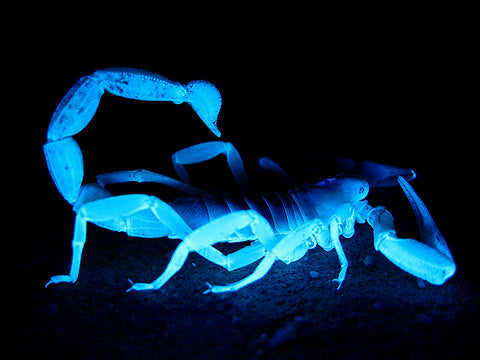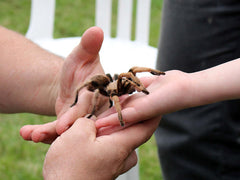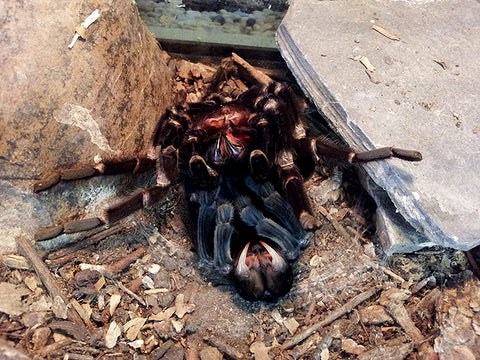Caring for Your Tarantula or Scorpion

Tarantulas and scorpions make unique and very interesting pets. Their care and handling requirements are similar, and thus are being covered in the same article. Both are relatively easy to care for and don’t take up much room.
This article covers the basics of how to care for your tarantula or scorpion and doesn’t include in-depth information about the various species. For more exhaustive information, please refer to specialized books or online resources.
Habitat/Housing
A ten gallon glass aquarium (20” x 10” x 12”) with a secure screen lid makes a good home for most sub-adult to adult tarantulas or scorpions. Juvenile tarantulas or scorpions can be housed in plastic “Kritter Keeper” containers. Very small spiderlings can be housed in small plastic deli cups or other small containers with air holes.
Tarantulas and most types of scorpions should be housed alone, as they are cannibalistic and may kill each other if kept together. Two exceptions are the Emperor Scorpion and the Pinktoe Tarantula, which are communal and can be housed in groups with others of their species, as long as they are all close to the same size.
Substrate (Bedding)
Most tarantulas and scorpions do very well with a deep layer (2”-4”) of coconut fiber bedding as substrate. Depending on the species of tarantula and what habitat it comes from, it can be kept dry or slightly moist (see the species profiles at the end for more details).
Cage Décor
Tarantulas and scorpions enjoy driftwood, branches, and artificial plants to climb on and hide under. Make sure any items are arranged securely so they cannot topple and injure your pet - or squash it if it burrows underneath.
Avoid using any rocks, branches, driftwood, or other materials that you have found outside. They may carry pathogens that could harm your pet, or may have been exposed to pesticides, herbicides, or other chemicals that could be dangerous to your pet. Most natural materials are porous and very difficult to completely sterilize. It is much safer for your pet if you use only professionally cleaned and sterilized items that are known to be safe.
Most species need a large, shallow water dish to drink from and to help raise humidity in the habitat. The water dish should be no wider than the leg span of your pet, and 1/2”-1” deep. You can put a thin layer of pebbles on the bottom of the dish if necessary to keep crickets from drowning. Sponges like the ones used for hermit crabs should not be used for tarantulas—they can’t get enough usable water through the sponge, and the sponges also harbor harmful mold and bacteria.
Other Necessary Supplies
- Thermometer
- Humidity gauge
- Spray bottle for misting
- Pet-safe cage cleaner
Maintenance
Remove soiled bedding and stale food weekly. Spot clean as needed. The entire cage should be cleaned and sanitized at least every 1-2 months. Clean enclosure and all décor with a 3% bleach solution, distilled vinegar and water (50/50), hydrogen peroxide, or pet-safe cleaning products.
Heating/Lighting
Heating

Tarantulas and scorpions are cold blooded (a.k.a. ectothermic) and don’t produce their own body heat. They rely on the temperature of their surroundings to heat or cool them. It is important that a habitat include a temperature gradient so your pet can self-regulate its body temperature.
For most species, daytime ambient air temps should range from 85° F at the warm end of the habitat, to 75° F at the cooler end. The temperature should stay above 70° F at all times.
The best way to heat most tarantula and scorpion cages is with an undertank heat pad. Make sure to get a size that covers approximately 1/3 to 1/4 of the bottom of the tank. Keep the heat pad plugged in at all times.
Another option is to use a heat lamp with a red or moonlight bulb that stays on all the time. These special bulbs emit heat and do not emit visible light that would disrupt the animal’s natural activity cycles.
Lighting
Most tarantulas and scorpions are nocturnal and avoid bright lights. Ambient room lighting is sufficient for most species. If you have live plants in your vivarium, additional lighting will be needed for the plants’ sake.
Any daylight bulbs that are used should be left on 10-12 hours a day, then turned off at night.
Diet
Tarantulas and scorpions need live insects as food. Crickets or dubia roaches are usually the preferred food, but some arachnids may accept mealworms or waxworms from tongs.
Appropriate-sized meals should be no larger than the abdomen of the tarantula, and no larger than 1/3 the size of a scorpion. Spiderlings and baby scorpions can be fed several times weekly, and larger arachnids can be fed once or twice weekly. You can offer one large prey item or several smaller prey items. Be sure not to leave more than one or two extra insects in your pet’s cage. Hungry crickets can sometimes attack a tarantula or scorpion, especially if it is molting! Many arachnids stop eating shortly before molting. If this happens, be sure to remove any extra insects right away.
Tarantulas and scorpions don’t need powdered supplements dusted onto their food, but there is another way to give your pet better nutrition. “Gutloading” is a system of feeding healthy foods to the feeder insects before they are eaten. That way, the arachnid also benefits. You can gutload the insects with a variety of fruits and vegetables, or with a commercially made cricket food.
Handling Tips
 Tarantulas and scorpions are wild animals, and would prefer not to be held or touched. Some species tend to be more tolerant of handling than others, although temperament varies by each individual.
Tarantulas and scorpions are wild animals, and would prefer not to be held or touched. Some species tend to be more tolerant of handling than others, although temperament varies by each individual.
All tarantulas and scorpions possess venom, although most are harmless to humans. It is important to be aware that there is a small chance that you could be allergic to the venom of any arachnid, even the ones considered generally harmless. Bites or stings of some species have been known to cause pain, swelling, and other symptoms. Be sure to research your particular species beforehand so you can be aware of any possible risks.
Many tarantula species possess urticating hairs, which they can fling in self-defense. It will use its back legs to brush its abdomen, kicking up a cloud of irritating bristles. These hairs can lodge in your skin and can cause itching, welts, rash, and swelling. Be sure to keep your face away from your tarantula, and not to rub your eyes after handling. Also, always wash your hands and arms after handling your tarantula or cleaning its cage. Benadryl can help with any irritation caused by urticating hairs.
Scorpions, along with the stingers in their tails, have powerful claws and can give quite a pinch. When cleaning your pet’s cage, you can safely move it by herding it gently into a plastic cup or container without actually touching it.
If you do decide to hold your tarantula or scorpion, it is best to sit on the floor. Arachnids can be easily killed by even a slight fall. Calmly approach your pet from behind and gently scoop it up from beneath using both hands. As it walks on your hands, be sure it is supported and safe from falling.
Molting
Most tarantulas and scorpions molt once or twice a year as adults, although younger arachnids may molt much more often. Molting is the process in which an arachnid sheds its old exoskeleton in order to grow. The arachnid will lay on its back to molt (don’t confuse this for dying—nearly all dead arachnids are found facing downwards).
After it exits the old exoskeleton, its new skin remains soft for several days while it expands and grows. Then the new layer hardens, which may take several days to a week. During this process, the tarantula or scorpion is extremely fragile and should not be moved or disturbed. Wait to handle or feed your pet until it is up and walking on its own, and back to its usual activity patterns.

Species Profiles
This is a general outline on care, and we recommend doing specific research on the species you are interested in before purchasing it. However, many common types of tarantulas and scorpions fall into one of three general categories: tropical terrestrial (ground-dwelling), tropical arboreal (tree-dwelling), or desert terrestrial.
TROPICAL TERRESTRIAL
(Includes Curly Hair, Mexican Red Rump, Mexican Red Knee, Emperor Scorpions)
Terrestrial tarantulas are burrowers, and prefer a deep level of substrate (2-4”). The substrate should be kept moist, but not dripping wet. A large, shallow water dish helps keep the humidity at correct levels (50-75%). Misting several times a week, or more, may be needed to help maintain humidity. Terrestrial arachnids prefer cork bark or driftwood to burrow under. Live plants are a great addition to make a beautiful, naturalistic vivarium.
TROPICAL ARBOREAL
(Includes Pinktoes (Avicularia sp), Suntigers (Psalmopoeus sp), Ornamentals (Poecilotheria sp)
In general, arboreal tarantulas tend to be slightly more specialized in their care requirements than terrestrial species, and are more sensitive in fluctuations in temperature and humidity. Most like higher humidity (60-80%), but also need plenty of ventilation. A substrate level of 2-4” of moist coconut fiber bedding helps keep humidity in the correct range. Daily mistings are usually needed, but make sure the habitat is allowed to dry slightly between mistings.
Live plants make a great addition to the habitat—they provide shelter as well as help maintain humidity levels. Arboreal tarantulas also enjoy cork bark or driftwood placed vertically for them to climb on and hide behind.
DESERT TERRESTRIAL
(Includes Rosehair, Greenbottle Blue, Mexican Blonde)
These terrestrial tarantulas are also burrowers, and prefer a deep level of substrate, which should be kept dry. 2-4” of coconut fiber bedding makes a good substrate. The water dish should be small to keep humidity to a minimum (under 50%). These tarantulas enjoy a piece of driftwood or cork bark placed horizontally in the cage so they can burrow under it. You can add live succulent plants to make the vivarium into a beautiful display.
Questions?
There are many online resources that thoroughly cover tarantula and scorpion care and health. The information provided here is meant to be a fun and helpful outline of the animal and its care requirements. By no means is it a comprehensive or exhaustive list. Always be sure to do your own research and consult an expert, such as a veterinarian, before making any decisions about your pet’s health.


